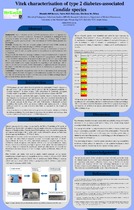Vitek characterisation of type 2 diabetes-associated Candida species

View/
Date
2017Author
Esmaio, Mustafa Hassan Mustafa
Abrantes, Pedro Miguel dos Santos
Africa, Charlene Wilma Joyce
Metadata
Show full item recordAbstract
Background: Type 2 diabetes mellitus (T2DM) predisposes patients to opportunistic infections, such as invasive candidiasis. Treatment of candidiasis is challenged by the emerging resistance of Candida species. In this study, the antifungal drug resistance patterns of Candida species present in the oral mucosa of T2DM Libyan patients was investigated.
Methods: Seventy four (74) oral Candida isolates collected from T2DM patients in Misrata, Libya were characterised using the VITEK 2 Compact system.
Results: Prevalent species included C. albicans, C. glabrata, C. dubliniensis, C. krusei, C. tropicalis, C. sake, C. kefyr, C. guilliermondii, C. parapsilopsis, C. membranifaciens and C. magnoliae.
Drug susceptibility showed an emerging resistance across representatives of all species for which breakpoints were available, with the exception of C. parapsilopsis. Although there are no established interpretative breakpoints for these species, three C. sake isolates and the C. membranifaciens isolate also had high MIC values for fluconazole. The tested isolates were found to be largely susceptible to caspofungin and micafungin. All C. albicans isolates were susceptible to the echinocandins, amphotericin B and 5-flucytosine. Resistance to more than one drug class was seen in C. dubliniensis, C. glabrata and C. krusei isolates.
Conclusion: Although the susceptibility results for the echinocandins were encouraging, resistance against the azoles was apparent and should not be ignored. This was especially so in the case of fluconazole, which is often the only locally available antifungal drug for the treatment of disseminated candidiasis.
